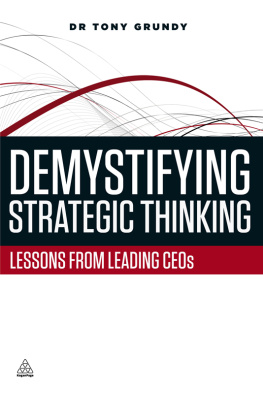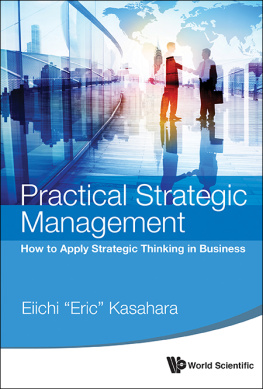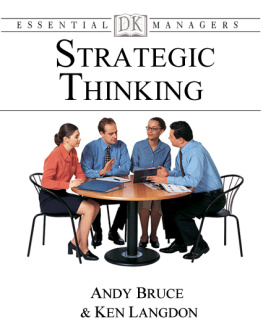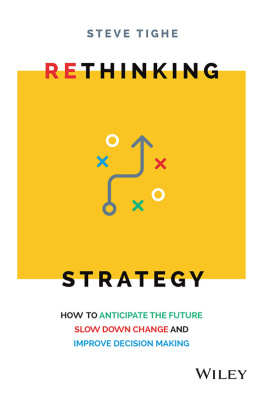Copyright 2015 by A.T. Kearney. All rights reserved. Except as permitted under the United States Copyright Act of 1976, no part of this publication may be reproduced or distributed in any form or by any means, or stored in a database or retrieval system, without the prior written permission of the publisher.
ISBN: 978-0-07-184875-6
MHID: 0-07-184875-4
The material in this eBook also appears in the print version of this title: ISBN: 978-0-07-184874-9, MHID: 0-07-184874-6.
eBook conversion by codeMantra
Version 1.0
All trademarks are trademarks of their respective owners. Rather than put a trademark symbol after every occurrence of a trademarked name, we use names in an editorial fashion only, and to the benefit of the trademark owner, with no intention of infringement of the trademark. Where such designations appear in this book, they have been printed with initial caps.
McGraw-Hill Education eBooks are available at special quantity discounts to use as premiums and sales promotions or for use in corporate training programs. To contact a representative, please visit the Contact Us page at www.mhprofessional.com.
TERMS OF USE
This is a copyrighted work and McGraw-Hill Education and its licensors reserve all rights in and to the work. Use of this work is subject to these terms. Except as permitted under the Copyright Act of 1976 and the right to store and retrieve one copy of the work, you may not decompile, disassemble, reverse engineer, reproduce, modify, create derivative works based upon, transmit, distribute, disseminate, sell, publish or sublicense the work or any part of it without McGraw-Hill Educations prior consent. You may use the work for your own noncommercial and personal use; any other use of the work is strictly prohibited. Your right to use the work may be terminated if you fail to comply with these terms.
THE WORK IS PROVIDED AS IS. McGRAW-HILL EDUCATION AND ITS LICENSORS MAKE NO GUARANTEES OR WARRANTIES AS TO THE ACCURACY, ADEQUACY OR COMPLETENESS OF OR RESULTS TO BE OBTAINED FROM USING THE WORK, INCLUDING ANY INFORMATION THAT CAN BE ACCESSED THROUGH THE WORK VIA HYPERLINK OR OTHERWISE, AND EXPRESSLY DISCLAIM ANY WARRANTY, EXPRESS OR IMPLIED, INCLUDING BUT NOT LIMITED TO IMPLIED WARRANTIES OF MERCHANTABILITY OR FITNESS FOR A PARTICULAR PURPOSE. McGraw-Hill Education and its licensors do not warrant or guarantee that the functions contained in the work will meet your requirements or that its operation will be uninterrupted or error free. Neither McGraw-Hill Education nor its licensors shall be liable to you or anyone else for any inaccuracy, error or omission, regardless of cause, in the work or for any damages resulting therefrom. McGraw-Hill Education has no responsibility for the content of any information accessed through the work. Under no circumstances shall McGraw-Hill Education and/or its licensors be liable for any indirect, incidental, special, punitive, consequential or similar damages that result from the use of or inability to use the work, even if any of them has been advised of the possibility of such damages. This limitation of liability shall apply to any claim or cause whatsoever whether such claim or cause arises in contract, tort or otherwise.
Throughout our careers we have been extraordinarily fortunate to learn from, work beside, and partner with the best. We gratefully dedicate this book to our mentors, colleagues, and clients who have inspired us to dig deeper and reach higherchallenging the status quo, always with the goal of making things better.
Contents
Acknowledgments
W E BEGAN THINKING ABOUT WRITING a strategy book in 2012, inspired by the many challenges that our clients were facing. Just like today, companies were struggling with more competitive markets and trends that were forcing smaller players out of business and leading bigger players to alter, and even shorten, their strategies. How do you deliberate over five- or ten-year strategies when your markets are being shaken by a bright new technology every six months? How do you stick to a long-term plan when an upstart challenger is doing everything faster, better, and cheaper than you are?
We had answers for these challenges, thanks to decades of research and experience working with organizations in most industries. But writing a book is never the work of just one, two, or three people. Our colleagues helped us by sharing their own expertise from their work with clients. This book incorporates our insights, learnings, and hands-on experience as well as those of our colleagues: Carol Cruickshank, Adam Dixon, Saurine Doshi, Richard Forrest, Laurent Guerard, Martin Handschuh, Angus Hodgson, Andres Mendoza Pena, Naveen Menon, Isabel Neiva, Joe Reifel, Sean Ryan, Priscilla Seki, Tak Umezawa, and Zuwairi Zakaria.
Steve Denning provided valuable support and expertise, becoming a sounding board for new perspectives and concepts. Patricia Sibo and Sharon Putman handled the overall revisions with great patience and professionalism, and, of course, we are grateful to Knox Huston at McGraw-Hill for his enthusiastic support and close cooperation.
Introduction
O NE OF US WAS HAVING DINNER some time ago when a colleague asked him why he didnt play chess. All strategists play chess, his colleague said, so why dont you? Everyone at the table was silent, waiting for an answer.
Years ago, our colleague would have had a point. In the 1980s, strategy was indeed like playing chess, which is done on a board with 64 squares and 6 unique pieces, or chessmen, that are allowed specific moves. Chess and strategy were about thinking ahead and anticipating competitors moves. Each could be done in a fairly analytical way, drawing on what had happened in the past. That IBMs supercomputer Watson was able to beat Gary Kasparov, the worlds best chess player in the 1990s, is evidence of this.
Today, strategy is very different. Imagine playing chess on a board that gets bigger in some areas, but smaller in others. You dont know where it will grow or shrink, or whether growth will occur in squares, circles, or triangles. Imagine that the number of pieces also changes. You can split pieces in two or merge them, and some pieces can become obsolete. On top of that, new moves are allowedrooks start jumping, and knights can run across the board. Some parts of the board vanish and new opportunities pop up, allowing your mutating stable of pieces to move in new and attractive ways, and, to top it off, more players start playing on your board.
Strategy today is about more than analyzing and anticipating predefined moves and thinking several moves ahead. It is also about determining where interesting opportunities for creating strategic advantage will arise, where new rules can work to your advantage, where the playing field might expand or contract, and where new threats might appear. It is also about howhow new pieces can help create or defend strategic advantage, and how to determine it is time to abandon once-promising game plans. Analytics wont solve todays problems, which is one reason why twenty-first-century strategy isnt like playing chess.
The Trouble with Strategy
In the past, business leaders turned to strategy to set the direction of the business and help them make choices amid the chaos. After all, for thousands of years, ever since Sun Tzu wrote The Art of War











